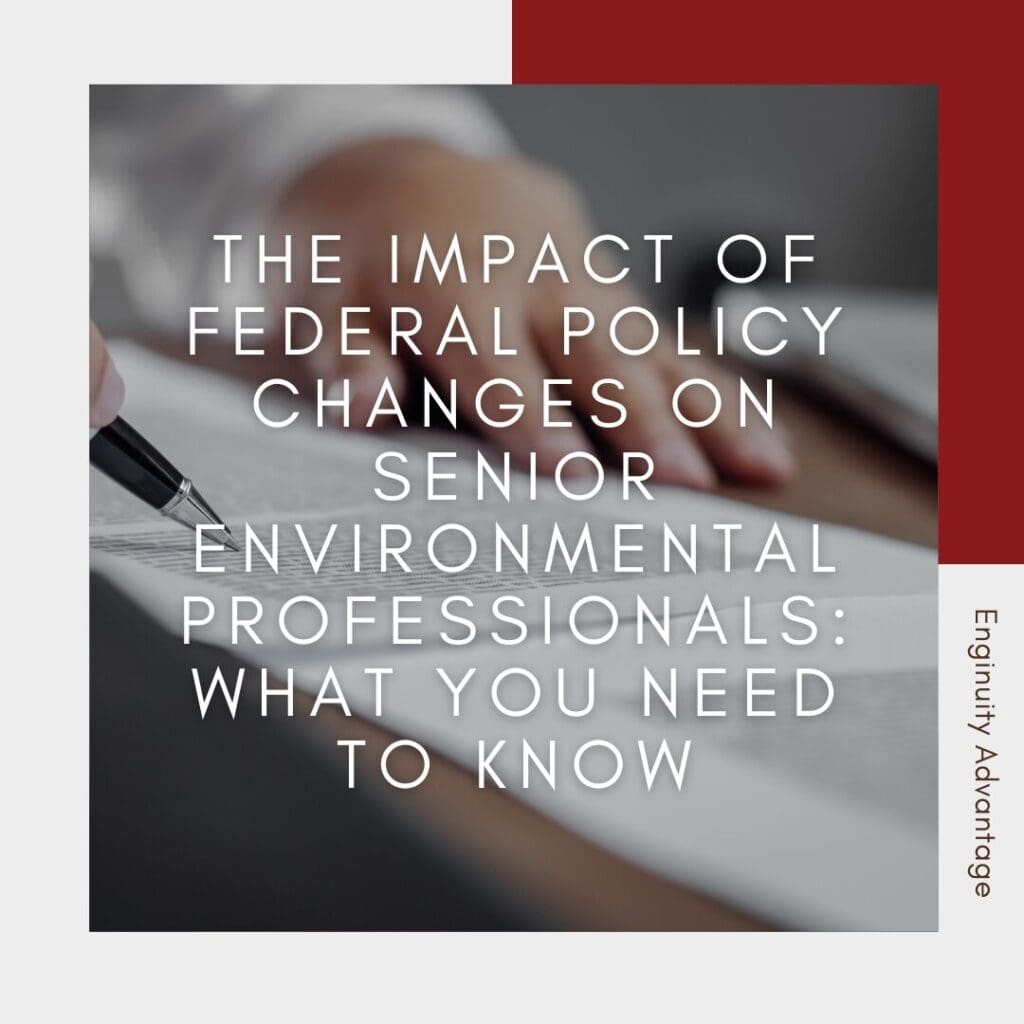The Impact of Federal Policy Changes on Senior Environmental Professionals: What You Need to Know

Environmental policy plays a crucial role in shaping the work of senior environmental professionals. As federal regulations shift in response to political, economic, and scientific factors, professionals in the environmental sector must continuously adapt to new laws and compliance requirements. Whether managing corporate sustainability initiatives, overseeing environmental impact assessments, or working in regulatory compliance, these policy changes can significantly impact day-to-day operations and long-term strategic planning.
Senior environmental professionals are often responsible for ensuring their organizations remain compliant while also identifying opportunities to integrate new policies into sustainable business practices. However, navigating federal policy changes requires a deep understanding of legal frameworks, environmental science, and industry best practices.
This guide explores the evolving landscape of federal environmental policy, examining key legislative shifts, their implications for senior environmental professionals, and strategies for adapting to new regulatory environments. By staying informed and proactive, environmental leaders can effectively manage policy transitions while driving sustainability and compliance efforts forward.
The Federal Environmental Policy Landscape: Past and Present
Federal environmental policy has evolved over the decades to address emerging environmental challenges. The National Environmental Policy Act (NEPA), enacted in 1969, set the foundation for modern environmental regulation, requiring federal agencies to assess the environmental impact of their actions. The Clean Air Act and the Clean Water Act followed, targeting industrial pollution and protecting vital natural resources.
In recent years, environmental policies have been influenced by political shifts, economic considerations, and growing public awareness of climate change. These policies have become more complex, requiring senior environmental professionals to navigate a constantly changing regulatory environment. Understanding how past regulations have shaped today’s policies helps organizations anticipate future developments and proactively adjust their sustainability strategies.
Recent Changes in Federal Environmental Regulations
The past decade has seen numerous changes in federal environmental policies, ranging from emissions controls and land conservation efforts to corporate sustainability initiatives. Regulatory updates have affected how businesses approach environmental compliance, resource management, and sustainability reporting.
The Clean Power Plan, initially introduced to limit carbon emissions from power plants, has undergone revisions, reflecting shifting federal priorities on climate action. Similarly, wetland protections under the Clean Water Act have been redefined, affecting industries that rely on land development. Adjustments in federal policies concerning hazardous waste management, air quality standards, and renewable energy incentives have further shaped the regulatory landscape.
Senior environmental professionals must stay informed about these changes, ensuring that compliance strategies align with the latest legal requirements while fostering a commitment to sustainable business practices.
Policy Compliance: A Strategic Responsibility for Senior Environmental Professionals
As regulations change, the responsibility of ensuring compliance falls largely on senior environmental professionals. They must develop compliance programs that align with federal mandates while also considering state and local regulations. Compliance efforts go beyond simply following the law; they require strategic foresight to integrate policy requirements into company-wide sustainability goals.
Environmental professionals must assess their organization’s operations to identify potential compliance gaps, adjust internal policies to meet new regulatory standards, and educate stakeholders on best practices. This proactive approach not only mitigates legal risks but also positions businesses as leaders in sustainability and corporate responsibility.
Industry-Specific Impacts of Policy Changes
Different industries experience unique challenges and opportunities as federal policies shift. The energy sector must adapt to emissions regulations and renewable energy mandates while manufacturing companies face new waste management requirements. Agricultural businesses navigate policies affecting water use and pesticide regulations, whereas construction firms must comply with evolving land use and wetland protection laws.
Understanding industry-specific implications allows senior environmental professionals to tailor their compliance strategies. By closely monitoring sector-specific regulatory updates and engaging with industry associations, businesses can align their operations with legal expectations while maintaining efficiency and profitability.
The Political Influence on Environmental Policy
Political transitions significantly influence environmental policies, with different administrations prioritizing various aspects of environmental regulation. Some governments emphasize climate action and stricter emissions controls, while others focus on deregulation and economic growth. These shifts can create uncertainty for businesses, making it challenging to develop long-term sustainability strategies.
Senior environmental professionals must adopt a flexible approach to policy compliance, preparing for regulatory fluctuations and adjusting corporate strategies accordingly. Engaging in policy discussions, advocating for balanced regulations, and maintaining adaptability are key to successfully navigating political changes that impact environmental regulations.
Leveraging Technology for Compliance and Sustainability
Technological advancements have transformed how businesses approach environmental policy compliance. Digital tools enable companies to track regulatory updates, automate reporting, and improve environmental data analysis. Geographic Information Systems (GIS) enhance land use planning, while artificial intelligence assists in regulatory trend forecasting. Blockchain technology is emerging as a solution for transparent sustainability reporting, ensuring accountability in environmental compliance efforts.
Investing in technology allows organizations to enhance efficiency, reduce compliance risks, and improve overall sustainability performance. Senior environmental professionals can leverage these advancements to streamline compliance processes and integrate data-driven decision-making into their environmental strategies.
Preparing for Future Policy Changes
Federal environmental policies will continue to evolve as new environmental challenges arise and scientific advancements inform regulatory decisions. Businesses must remain proactive by anticipating policy trends and preparing for future regulations.
Developing internal frameworks for environmental risk assessments, fostering a culture of continuous learning, and engaging with policymakers can help businesses stay ahead of regulatory changes. By implementing long-term sustainability strategies, companies can align their operations with evolving environmental expectations while strengthening their market position.
Strengthening Organizational Sustainability Practices
Beyond compliance, businesses can use federal policy changes as an opportunity to enhance their sustainability initiatives. Reducing carbon footprints, improving resource efficiency, and investing in renewable energy projects align with regulatory goals while benefiting long-term business success. Companies that integrate sustainability into their core operations position themselves as industry leaders and attract environmentally conscious investors and customers.
Senior environmental professionals play a crucial role in guiding their organizations toward sustainable practices. By aligning corporate goals with regulatory expectations, businesses can ensure compliance while contributing to broader environmental objectives.
Understanding the Economic Impact of Environmental Policy
Federal policy changes do not only impact compliance but also influence business profitability and economic stability. Environmental regulations can introduce new costs for companies in the form of carbon taxes, compliance fees, or investment in cleaner technologies. However, they can also open up opportunities for businesses to innovate, improve operational efficiency, and gain competitive advantages in a shifting marketplace.
Companies that proactively integrate sustainability into their financial planning and operations can offset regulatory costs by capitalizing on government incentives, tax credits, and grants related to green technology adoption. Understanding the economic implications of federal policies allows organizations to make strategic investments that align with long-term financial and environmental objectives.
Adapting to an Ever-Changing Regulatory Environment
Federal policy changes create challenges and opportunities for senior environmental professionals. Staying informed about regulatory updates, leveraging technology for compliance, and integrating sustainability into corporate strategies are essential for navigating an evolving environmental landscape.
By adopting proactive approaches and fostering a commitment to environmental responsibility, businesses can ensure compliance while driving meaningful sustainability initiatives. At Enginuity Advantage, we provide expert resources to help organizations adapt to regulatory changes and implement best practices for long-term environmental success. Senior environmental professionals who embrace adaptability and strategic planning will lead the way in shaping a more sustainable future.
Unlock Dream Careers & Elite Talent: Just One Click Away!


